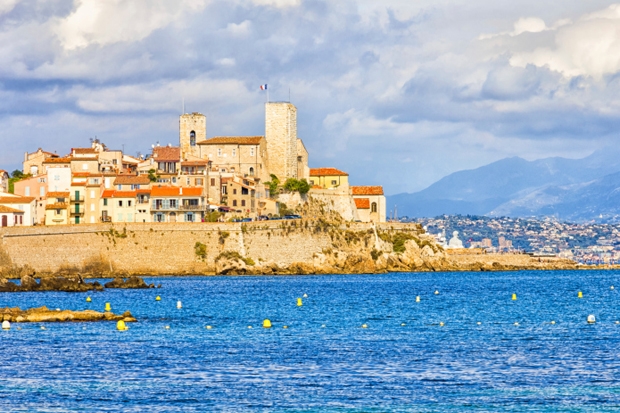The hotel and its bright tan prayer rug of a beach were one. In the early morning the distant image of Cannes, the pink and cream of old fortifications, the purple Alp that bounded Italy, were cast across the water and lay quivering in the ripples and rings sent up by sea-plants through the clear shallows.
Recognise it? F. Scott Fitzgerald’s Tender is the Night. First page. Hollywood starlet Rosemary Hoyt and her mentoring mother take ground-floor rooms at a quiet beachside Antibes hotel. Rosemary wanders out and on to the aforementioned beach, takes off her bathing robe, wades into a ‘blue as laundry water’ sea, then ‘laid her face on the water and swam a choppy four-beat crawl out to the raft’. Returning ashore, she finds a space on the beach beside a party of rich and languid Americans, spreads out her peignoir on the sand, and lies down to sunbathe.
‘Lying so, she first heard their voices and felt their feet skirt her body and their shapes pass between the sun and herself. The breath of an inquisitive dog blew warm and nervous on her neck.’
I love that inquisitive dog. Who hasn’t sunbathed on a beach with eyes closed and felt that warm, nervous snuffling? The unfolding story is Rosemary’s growing infatuation with Dick, the leader of the languid ones. And I have loved Scott Fitzgerald’s pine-fringed prayer rug of a beach ever since I read his patchy novel for the first time in my twenties. That fictional Riviera beach stands out more vividly in my imagination than most of the real ones I’ve sat on. So, as you might imagine, I was rather excited, while staying last week in Antibes, and idly browsing the web for tourist information, to read that a west-facing Antibes beach called la Garoupe is the selfsame beach described by Fitzgerald at the beginning of Tender is the Night. The link was credible, too. Not every local website that stood to gain commercially by such a glamorous connection seemed aware of it. Apparently, Scott and Zelda rented a succession of villas between St Raphael and Antibes and used to frequent la Garoupe.
I am a literary pilgrim of the most open-mouthed sort. It must be a type of cretinism to enjoy fiction and then physically to visit the settings and to want so badly that the fictions be somehow present and tangible. Perhaps it is a vice akin to masturbation. And here at Antibes, I now discovered, a mile from the hotel, just beyond the pines on the headland, is my everyone gone out, have a soak in the bath first, put some music on wank of the decade.
I jumped in the car. At the end of the coast road was a narrow, sandy car park bordered by a high chain-link fence through which I could see a tatty restaurant (shut for the winter) overlooking a tiny, narrow crescent beach — la Plage de la Garoupe. The beach was prettily encircled by opposing headlands. Five miles away across smooth water I could see the hideous concrete sprawl of Cannes and Nice, and behind these the French Alps, their snowy peaks against a cloudless Mediterranean winter sky. If I shut one eye and half-closed the other, and ignored the car park and dilapidated restaurant, and the EasyJet airliner with its undercarriage down coming in to land at Nice airport; and if I made allowance for the unsightly heaps of sand at the back of the beach, bulldozed there to preserve it all from being scattered by the winter storms; and if I forgave the beach’s disappointing narrowness and tried to convince myself that this was a hot July morning, the dew on the pines evaporating rapidly, then yes! actually, yes!, it was possible to see Dick Diver in his jockey cap raking pebbles from the sand with a burlesque show of seriousness and application, and laconic Abe North, and Tommy Barban reading aloud and cynically from the local newspaper, and Nicole’s pearls against her tan, and the gaudy changing-tent, and the inflatable rubber horse, and the beach umbrellas, and Rosemary Hoyt lying on her back choosing Dick with her eyes.
The next morning, mining the web again for local information, I was surprised to read that Graham Greene, no less, lived in Antibes for 24 years, from 1966 until 1990. I dashed out right away and eventually found La Résidence des Fleurs in Avenue Pasteur and asked a passer-by to snap me leaning against the small, rather curt commemorative plaque. And even though it has probably changed hands 15 times since then, I went for lunch, as Grim Grin did almost every day, at the Cafe Felix, beside the south port gate.
I tell you, it’s at best a vice and at worst a sickness, this thing I have. And so boring for others.







Comments